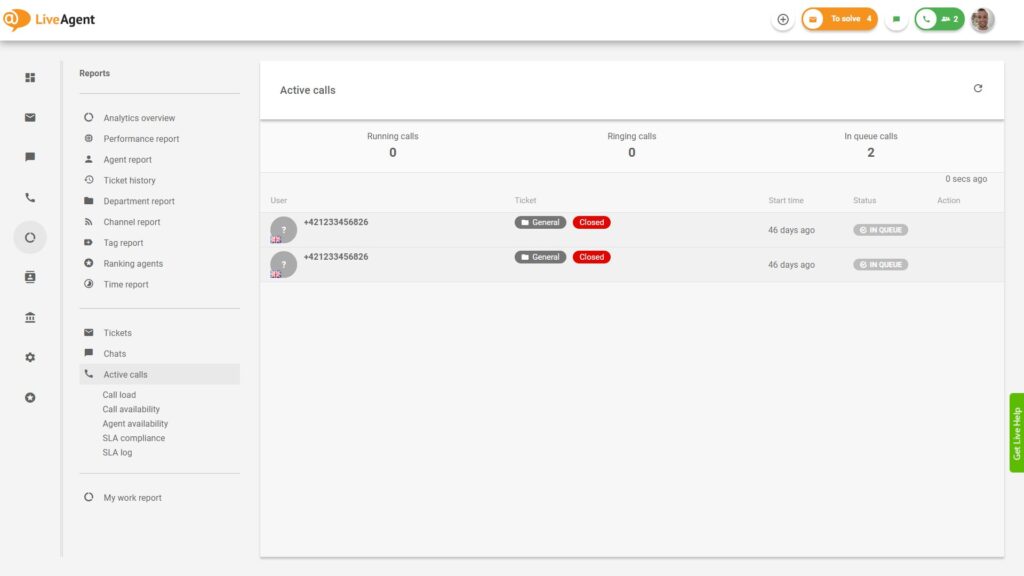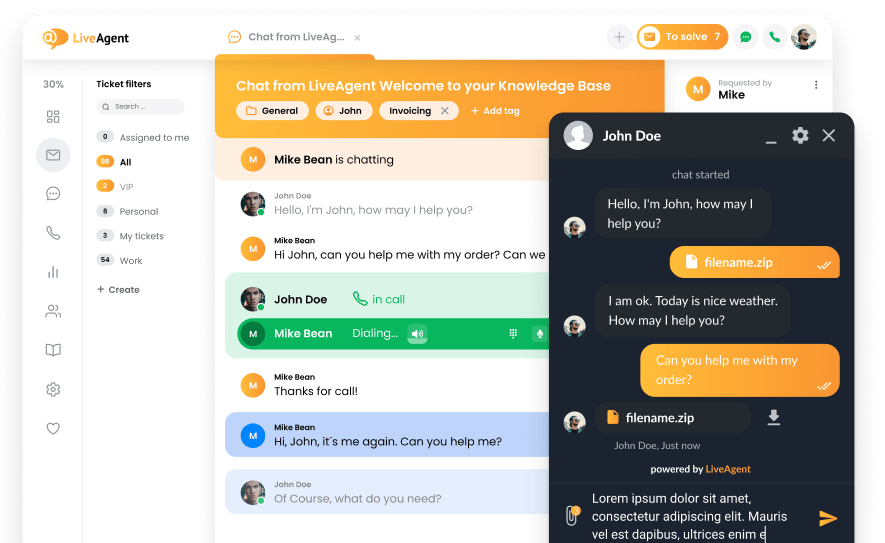An effective call center has specific measurable performance criteria. These can be certain established processes, workflows, procedures, and guidelines for agents to follow. It is essential to conduct a periodic call center audit. It ensures a call center consistently remains fully optimized for maximum efficiency and effectiveness.
The goal of an audit is to get a full view of what is happening in the call center. This is for your company to understand the processes, technologies, and more. Therefore, your company can easily identify gaps in call center performance. Use the gathered data and take an action in order to correct these gaps. Below is a basic call center audit checklist you can use in your own audit customer service process.
1. Call center performance
When evaluating the overall call center performance, you might take into account the following call center metrics:
- Average calls per agent: if there are more calls than agents can handle, it may signal that more staff should be hired.
- Cost per call: displays the total cost involved in handling calls during a specific period of time. It also provides an insight into the ROI of the involved expenses.
- Service level: directly tied to customer service quality and inbound call center performance. It shows whether a call center has enough resources to resolve customer issues quickly.
- Average speed to answer: if the metric is high, it also indicates that you may need to employ additional employees. Thus, to maintain customer satisfaction.
- Average handle time: a high average handle time means that customers are waiting a long time in between responses. This is often a sign that agents need additional training.
- Abandonment rate: a high abandonment rate might result in dissatisfied customers and lost sales opportunities.
- Forecast accuracy: if actual calls are higher than predicted, the team most probably works under pressure. If there are fewer calls than the forecast indicates, the agents are under-utilized.
If you would like to learn more, read – Call center metrics you should be measuring right now.
2. Agent efficiency
When it comes to analyzing individual call center agent efficiency, the following metrics might be helpful:
- Adherence to schedule: a high rate indicates that an agent is sticking to their schedule. Therefore, offering customer service when expected.
- Maximum occupancy rate: determines how busy agents are, and whether a call center is overstaffed or understaffed.
- First call resolution: high FCR means high productivity since an agent takes less number of interactions to resolve issues.
- Quality assurance scoring: demonstrates the quality of calls. Thus, how good an agent is in call handling, problem-solving, script adherence, following protocols, and using proper call center etiquette.
3. Processes and procedures
When assessing call center operations, verify all procedures, policies, and customer service processes. These should be all well-defined, well-documented, understandable, and easily accessible to everyone in your call center team. For a more in-depth analysis, evaluate if all the steps in processes and procedures are necessary and relevant. Plus whether any of them can be combined or eliminated altogether.
4. Call center scripts
Review your call center scripts to ensure they provide customers with accurate information. Therefore, leaving no room for ambiguity. Make sure your agents are able to use them correctly and effectively to maintain high levels of customer satisfaction. The following questions might be helpful in your evaluation:
- Are your call scripts well-crafted and worded in a simple language by your target audience?
- Do you refresh your scripts whenever something changes within your company?
- Do you encourage agents to go off-script when they feel it’s more appropriate to the situation?
5. Call center recruiting
To ensure a steady stream of qualified applicants, your recruiting strategy should be robust, efficient, and catered to the needs of your organization. When reviewing your recruitment process, evaluate the effectiveness, accuracy, and relevance of the following:
- Your hiring criteria include the customer service skill set and qualifications required for every position.
- Job descriptions for the roles and whether they match with actual agent duties and responsibilities.
- Your pre-hire assessments, candidate background checks, interview structure, and questions.
6. Agent onboarding and training
To fully leverage your call center resources, you need to have a solid agent onboarding and training program. Review your employee onboarding procedure. Moreover, analyze its effectiveness in introducing policies, practices, software, and helpful information to your new hires.
When it comes to agent training, the audit should identify whether your training program is addressing the right training needs. Moreover, how effectively it can be tailored to individual agents’ requirements and skills gaps.
7. Employee engagement
Audit employee engagement and internal communications in your call center by answering the following basic questions:
- Do you recognize and reward the best agents?
- Do agent rewards drive performance?
- Can you easily identify poor performers? Are there processes in place to improve their skills?
- Do you provide the opportunity for agents to learn, develop, and grow?
- Do agents feel that their opinions matter and count?
- Are agents faced with any pressure in the workplace?
8. Workforce management
Conduct a workforce management review. It ensures the right number of agents with proper skillsets are staffed at the right time. Apart from analyzing forecast accuracy, review how schedules are created or whether agent preferences are taken into account. Determine any issues that may be affecting the efficiency of the process of scheduling and assigning agents to shifts.
9. Agent turnover
Calculate agent attrition (employee turnover) rate. A high number usually means higher costs of re-recruitment and re-training of replacements. In addition, the lower productivity of new/inexperienced hires can also have a negative impact on the level of service provided. If your turnover is excessive, you may need to conduct a more in-depth audit to determine the reasons.
10. Customer satisfaction
Measure customer satisfaction in your call center. It comes down to measuring the following most used metrics:
- Customer Satisfaction Score: considering that satisfaction scores can vary widely based on the type of CSAT question asked. The closer the number to 100%, the better.
- Net Promoter Score: though NPS scores can range between -100 and +100. A score closer to +100 is good. Whereas a negative score means more customers are not likely to recommend you.
- Customer Effort Score: while the average score would be somewhere between 1-5, the lower the number, the better. This means that customers have a low-effort experience.
Discover on your own
Knowledge is important, but only when put into practice. Test everything in our academy right inside the LiveAgent.

Try out LiveAgent for FREE
Handle all customer inquiries from one interface. Start improving your customer service with a 30-day free trial right away!
Frequently Asked Questions
Why is it essential to conduct a periodic call center audit?
It is important to conduct a periodic call center audit because it ensures a call center consistently remains fully optimized for maximum efficiency and effectiveness.
What call center metrics measure agent efficiency?
To measure agent efficiency, consider First call resolution, Quality assurance scoring, and Adherence to schedule.
What is a good Net Promoter Score?
NPS scores can range between -100 and +100. A score closer to +100 is good. Whereas a negative score means more customers are less likely to recommend you.
Effective outbound call center software
Boost sales with LiveAgent's CRM-integrated outbound call center software. Enjoy 24/7 support, no setup fees, and a 30-day free trial!

 Български
Български  Čeština
Čeština  Dansk
Dansk  Deutsch
Deutsch  Eesti
Eesti  Español
Español  Français
Français  Ελληνικα
Ελληνικα  Hrvatski
Hrvatski  Italiano
Italiano  Latviešu
Latviešu  Lietuviškai
Lietuviškai  Magyar
Magyar  Nederlands
Nederlands  Norsk bokmål
Norsk bokmål  Polski
Polski  Română
Română  Русский
Русский  Slovenčina
Slovenčina  Slovenščina
Slovenščina  简体中文
简体中文  Tagalog
Tagalog  Tiếng Việt
Tiếng Việt  العربية
العربية  Português
Português 






